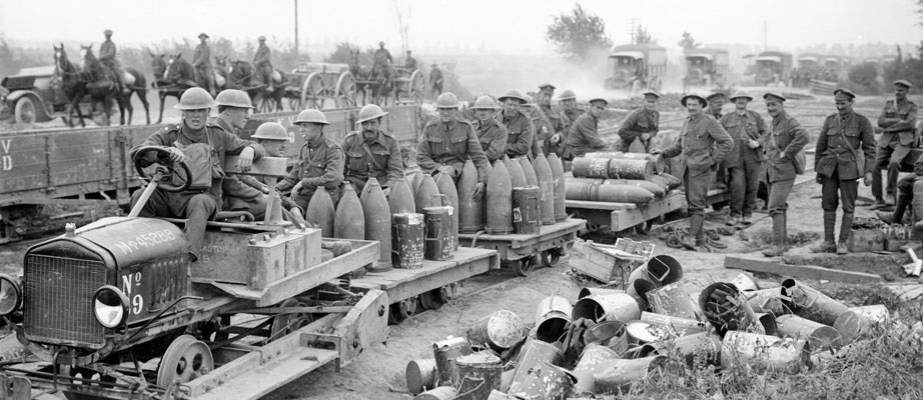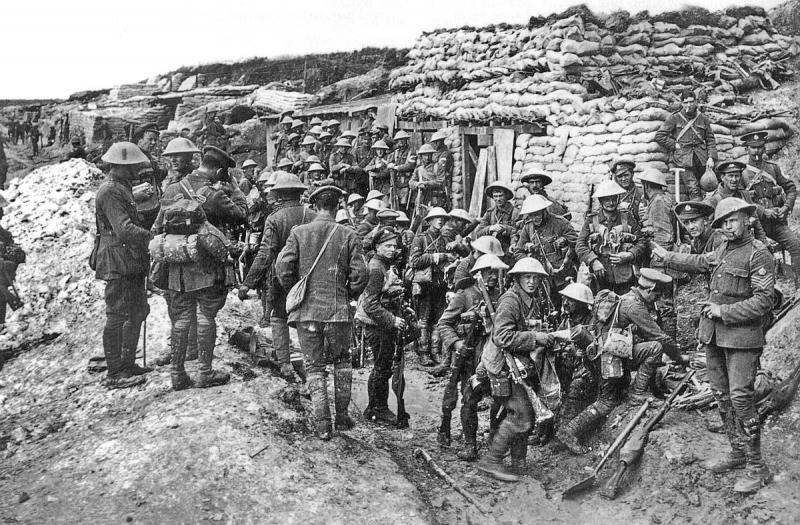Millions of Artillery Shells Planned at the Somme;
‘Nothing Could Exist at the Conclusion of the Bombardment.’
Special to The Great War Project
(5-8 May) On the Western Front during these days one hundred years ago, the British are preparing for something big.
Many believe they are getting ready for a big push at the River Somme, in northern France.
“All was being prepared for the battle of the Somme,” writes historian Martin Gilbert, “Daily British raids across No-Man’s-Land kept the soldiers on both sides of the line at constant readiness for action.”

Artillery shells arrive at British positions near the Somme by rail, spring 1916.
At the same time, “through the docks of French ports,” reports historian Adam Hochschild, “flowed a torrent of supplies… as they prepared to smash through the German lines near the Somme.”
The numbers are staggering. Half a million British troops deployed along an eighteen-mile stretch of the front.
“This was to be the ‘Big Push’,” Hochschild reports, “a concentration of manpower and artillery so massive and in such a small space that the German defenses would burst open as if hit by floodwaters.”
“Once that happened, the generals believed, a key weapon in the hands of the soldiers pouring through would be the bayonet.”
“After the Germans had been bayoneted in their trenches,” the British commander believes, “it would be a matter of…fighting the enemy in the open, and so battalions were trained intensively in maneuvering across trenchless fields and meadows.”
“Finally of course, charging through the gap in the lines would come horsemen from three cavalry divisions.”

British troops in preparation for ‘the Big Push’ at the Somme, spring 1916.
If this sounds like an almost ancient fom of warfare, it is. The difference is the scale of the preparations. “That belongs to the era of mass production,” Hochschild observes. “Troops unrolled 70,000 miles of telephone cable.” Ammunition appeared in massive dumps. Miles of new railway are being laid, as are new roads.
“With as many British soldiers crammed into the launching area as the population of a good-sized city, wells had to be dug and dozens of water pipe laid. Horses, tractors, and more sweating soldiers maneuvered heavy artillery pieces into position – no easy job when a single eight-inch howitzer weighed thirteen tons.”
According to the plan, British soldiers are to cross no-man’s-land in precise successive waves. What about the Germans’ deadly use of machine guns, which has been so effective in other battles? Simple, observes Hochschild. Artillery.
“The preattack bombardment would destroy not just the Germans’ barbed wire but the trenches and firing positions that sheltered their riflemen and machine-gunners. How could this not be when there was one artillery piece for every 17 yards of front line?”
That would rain a total of a million and a half shells down on the German trenches over five solid days.
The preparations for the attack are so obvious that there’s no chance this offensive will be kept secret. But the commanders who dream up this plan – 35 pages long for the first day – believe it is so massive and well thought out that “nothing could exist at the conclusion of the bombardment.”

Horses pull supply carts in all weather conditions, date uncertain.
As for the Germans, they have launched no major attacks on the Somme sector for a year and a half. They use this time to strengthen their defenses, a development that the British are not fully aware of.
There are signs that the German defenses are strong, but the British commanders brush that off.
